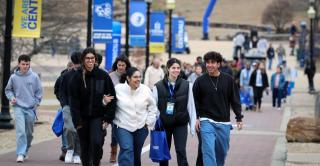
When the university community convened to celebrate the official ribbon-cutting of the newly renovated Willard-DiLoreto complex on Feb. 20, hundreds of well-wishers attended the festivities for what most agreed was an exciting development. But for Dr. Zulma R. Toro, the completion of the $63 million total gut renovation of the two buildings marked a particularly special moment.
“To see this beautiful building completed is particularly meaningful to me,” she said. “I arrived on campus on the same day the university broke ground on this project. I have able to watch its progress from start to finish, and I am thrilled with the result.”
That day was Nov. 9, 2016. Two years, 250,000 bricks, and 350 tons of structural steel later—give or take—the university has checked off another box on the list of construction priorities identified in the “2020 program,” a plan that originated in 2007 to fund necessary construction projects on state college and university campuses.
“With every improvement we make on our campuses, the more successful our students will be,” Toro said. “I truly appreciate the investment the state legislature made in this university when its members voted to approve the funding for the 2020 project.”
The Willard-DiLoreto project called for complete exterior masonry replacement, significant structural repairs and enhancements, new mechanical systems, roofs, windows, and doors, and comprehensive reconfiguration of space to provide additional classrooms, offices, and recreational space, according to David Barkin, chief architect of the state Department of Administrative Services.
Next up, Facilities Management staff will get to work on an adjoining pedestrian bridge that will connect Willard-DiLoreto and a planned parking garage that will replace Lot D on Manafort Drive. Additional plans are in the works to begin an addition and renovations to Henry Barnard Hall, a project due to be completed in Spring 2021.
The new Willard-DiLoreto comprises 141,000 square feet total, which includes a 40,000-square-foot atrium infill, an addition that area of campus that connects Willard Hall to DiLoreto. The atrium bears the name of donor and alumna Carol A. Ammon, after whom the University named its College of Liberal Arts and Sciences in 2007. Four academic departments that fall under the Carol A. Ammon College of Arts and Sciences and the college’s dean’s office are located in the complex.
“That atrium really brings the whole thing together,” says Interim Chief Facilities Officer Sal Cintorino. “This created another space where, between classes, students can congregate and collaborate and get together. And it’s certainly an attractive centerpiece for the building.”
Ammon attended the ribbon-cutting and remarked on the changes to campus since she started her academic career here 50 years ago.
“I thank everybody who participated in this project,” Ammon said. “I am so proud—so overwhelmed to be standing here, and I hope that everybody in the future can take from this university what I’ve been able to take.”
University officials are equally proud of a new layer of convenience the complex provides.
Instead of “ping-ponging” students all over campus to conduct necessary transactions and access services, all 50 student services offices are centralized in Willard-DiLoreto, from the Bursar to the Writing Center.
“Now students can be easily referred to an office down the hall or next door. Moreover, we have designed these offices with student privacy and comfort foremost in our minds,” Toro noted. “By crafting this one-stop shop for services, we aim to serve our students more efficiently, save them some time, and encourage more interaction and collaboration within the Central family.”
Other highlights include a new, state-of-the-art Wellness Services suite—staff moved in over spring break—and a Zime café operated by Sodexo. The eatery offers coffee, baked goods, sandwiches, and more.
Overall, the renovation elevates the student experience, according to Toro.
“We have made these upgrades with the whole student in mind,” she said. “Along with their academic growth, we must also encourage their personal and professional development. To accomplish that, we must cultivate an environment conducive to productive inquiry — and the project we have completed, reinforces that commitment and it will spur us on to the next chapter of the Central story.”
Fast facts: Willard-DiLoreto Hall
The plan: Complete gut renovation of Willard and DiLoreto halls and the construction of an infill addition of an atrium between the buildings.
Total cost: $63 million
Groundbreaking: Nov. 9, 2016
Size: 143,000 sq. ft.
Instructional labs: 5
Classrooms: 24
Academic offices: 57, including Carol A. Ammon College of Liberal Arts & Social Sciences Dean’s Offices
Academic departments: 4: Philosophy, English, Journalism, Modern Languages
Student Services: 50 offices in the atrium centralize key student support services, including Financial Aid, Registrar, Veterans Affairs, and the Learning Center, among others.
Building bios
Frank J. DiLoreto Hall
Constructed in 1969, the social sciences academic building was named to honor the legacy of Frank J. DiLoreto (March 20, 1922 – May 20, 1964), a New Britain native, lawyer, and state senator who advanced significant legislation on behalf of the Connecticut state college and university system.
In the 1961 session, he was named chairman of the state education committee, which went on to launch the Commission on Higher Education and the state scholarship program. During his tenure in the Senate, Mr. DiLoreto championed an unprecedented number of appropriations for capital expenditures for the four state colleges. He also expanded the facilities at all of the state’s colleges and technical schools and increased state educational aid to towns.
Emma Hart Willard Hall
Though it got its start in 1959 as the Elihu Burritt Library, the building was renamed in 1972 for Emma Hart Willard and was designated as a classroom building as new, larger library opened its doors on the other side of campus.
Emma Hart Willard (Feb. 23, 1787 – April 15, 1870) was a Berlin, Conn., native who championed educational opportunities for women.
As a teacher and advocate, she sought to expand the typical curricula offered to female students—studies often limited to music, dance, needlework, and French. Her “Plan for Improving Female Education,” drafted in 1819, called for women to receive instruction in the same subjects taught at men’s higher education schools, including higher mathematics, philosophy, geography, history, and science. In 1821, she opened the Troy Female Seminary in New York, the first school to offer higher education to women.



